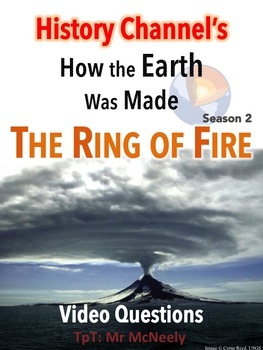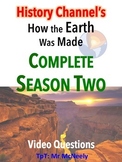History Channel's How the Earth Was Made: The Ring of Fire Video Worksheet
- Zip
What educators are saying
Also included in
- How the Earth Was Made Season 2 is a wonderful 13-episode earth science documentary series that was originally broadcast on the History Channel. The episodes are set up as detective stories, where multiple lines of evidence are used to come to reasonable conclusions. You will need to obtain DVDs ofPrice $19.00Original Price $26.00Save $7.00
Description
History Channel's How the Earth Was Made is a wonderful earth science documentary series. The episode titled "Ring of Fire" is the story of the discovery of the forces that create a deadly ring of volcano and earthquake zones around the edge of the Pacific Ocean. The episode is set up as a type of detective story, with evidence shown to back up a hypothesis. You will need to obtain a DVD of the video or locate an internet site for streaming.
The video worksheet is a one-page, double-sided handout consisting of 51 multiple choice questions that track the progress of the video. This format enables the students to pay attention to the video while quickly recording their answers. In this way, the students are not bogged down in writing long responses, and they can better enjoy watching the video. A key is included, and the files are provided in both MS Word and PDF formats.
Other Resources:
A Google Forms, self-grading quiz of the video worksheets is available here. (Note: Access to the Google Quiz requires an extra payment.)
A Google Doc version of the video questions worksheet is available here. (Note: Access to the Google Doc requires an extra payment.)
The video is available for streaming on the History Channel official YouTube site. (Please make sure that the video is accessible before purchasing this TPT resource.)
Overview: How the Earth Was Made: Ring of Fire
The Ring of Fire refers to the edge of the Pacific Ocean, the site of many volcanic and earthquake disasters. The most visible features of the Ring of Fire are its volcanoes, which surround the Pacific Ocean and extend from South America to Alaska, through Russia, Japan, and Southeast Asia, and all the way to New Zealand. Several notable volcanic eruptions have occurred here in the recent past: Krakatoa in 1883, Mt. St. Helens in 1980, and Pinatubo in 1991.
The story starts in Alaska, which is home to 75% of volcanoes in the United States. Like other Ring of Fire volcanoes, Alaska’s Mt. Augustine is a tall, pointy stratovolcano that emits an explosive type of “blocky” lava. This lava, which is viscous and resists flowing, traps volcanic gases and can explode once it reaches the surface. Viscosity is determined by the amount of silica in the lava, and Ring of Fire volcanoes often feature this dangerous blocky lava. Stratovolcanoes can also generate dangerous pyroclastic debris flows of ash and gas with temperatures of 1,300° F and speeds over 100 mph.
Minerals such as hornblende found in Ring of Fire lavas indicate that water somehow made its way underground to become part of the magma that erupts on the surface as lava. The video highlights Mt. Lassen in California, where scientists sample the gas emitted by hot springs, boiling mud, and volcanic vents. The presence of carbon-12 in the gas mix indicates that material from the seafloor makes its way under the edge of the continent to become part of the magma beneath California. Carbon-12 is a signature of tiny sea organisms named phytoplankton which die and form sedimentary layers on the ocean floor. It appears that water from seafloor sediments contributes to the formation of Ring of Fire volcanoes, despite the magma often lying hundreds of miles from an ocean. In Alaska’s Chugach Mountains, rocks are observed on the surface that contain material that was originally deposited as layers on the sea floor. In particular, the rocks contain limestone, which fizzes when acid is applied. It appears that these ocean floor rocks were moved onto land by the enormous process of subduction, where seafloor moves down and under the land, and that bits of the ocean floor accreted, or became scraped off onto the land.
The Ring of Fire is responsible for 90% of the world’s earthquakes, which extend in a narrow band around the Pacific. Notable Ring of Fire earthquakes include Alaska in 1964, Mexico City in 1985, and Sumatra in 2009. The Great Alaska Earthquake of 1964 is the second strongest earthquake ever recorded (the first is the Chilean earthquake of 1960 and, at magnitude 9.6, another Ring of Fire earthquake). Powerful ground movements from this quake were detected up to 4,000 miles away. To demonstrate the power of the 1964 earthquake, the investigators visit Prince William Sound and observe that old, boulder lined beaches are positioned about 20-25 feet above the current sea level. This provides evidence that the ground itself had been raised during the 1964 earthquake. The quake also devastated Anchorage, and, at magnitude 9.2, shook the ground for 4 ½ minutes. This type of powerful Ring of Fire earthquake is called a megathrust. These earthquakes not only shake the ground and cause uplifts, they can also generate destructive sea waves named tsunamis. The 1964 Alaska earthquake produced a 200 foot high tsunami that traveled over 1,700 miles, and that even caused deaths in California. In recent times, the notorious Indian Ocean tsunami occurred in 2004, and claimed over 200,000 lives (the Japanese tsunami of 2011 occurred after the video was made).
Along with volcanoes, subduction also generates the deadly megathrust earthquakes of the Ring of Fire. Shallow earthquakes occur near shore along the edge of the ocean. With measurement, earthquakes become progressively deeper as you move in away from the ocean. Scientists can use the location and depths of earthquakes to demarcate the top of oceanic material subducting beneath an adjacent continent. This data is obtained using seismic stations located throughout North America. Alaska itself generates about 1,500 earthquakes per month, and this type of activity extends all around the Ring of Fire.
Mapping of the sea floor using echo-sounding technology reveals the presence of deep ocean trenches that surround the Pacific Ocean, and that are adjacent to the volcanic and earthquake zones mentioned above. These trenches represent the deepest places on Earth (the Marianas Trench is a famous example), and the largest could swallow Mt. Everest. If the oceans were drained, the Pacific seafloor would be revealed to be an immense slab of rock, or plate, bounded by these deep ocean trenches. This huge Pacific Plate is one of 14 plates that cover the entire Earth. Subduction occurs where the Pacific Plate rubs up against neighboring plates, and is forced under.
The Ring of Fire and Pacific Plate are part of the worldwide motion of Earth’s plates. GPS stations reveal that North America, for example, is moving westward 3 inches per year. Earth’s plates are able to move because they are positioned atop a hot, soft layer of rock in the mantle. Convection, the upward motion of hot rock in the mantle, and that is similar to boiling water or a lava lamp, is likely the force that pushes Earth’s plates. One final mystery of the Ring of Fire is an explanation of how the Pacific Plate is able to survive if its edges are continually destroyed due to subduction. Scientists reasoned that the plate must also exhibit areas of volcanic growth that replaces the lost edges. In 1977, scientists aboard the submersible Alvin began to hunt for these volcanic regions at the bottom of the oceans. The scientists searched for deep, warm ocean water. They eventually identified rock columns that pump out superheated water, in excess of 750° F, that was dark and laden with minerals. These “black smokers” were found to mark the locations of mid-ocean ridges that resemble giant undersea mountain ranges.
Powered by Earth’s internal heat, plate tectonics is a force that has occurring for the past 200 million years in Alaska, and that likely started much earlier in Earth history. Subduction will continue long into Earth’s future, and will rewrite the map of Earth’s globe. If current trends continue, Hawaii and parts of California will continue moving towards Alaska. In summary, subduction of the Pacific Plate is the main force driving the volcanoes, earthquakes, and mountain building episodes of the Ring of Fire. Subduction is a manifestation of tremendous and unprecedented forces of heat transfer within the Earth’s mantle.






